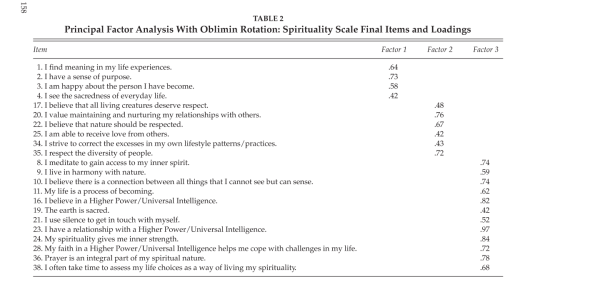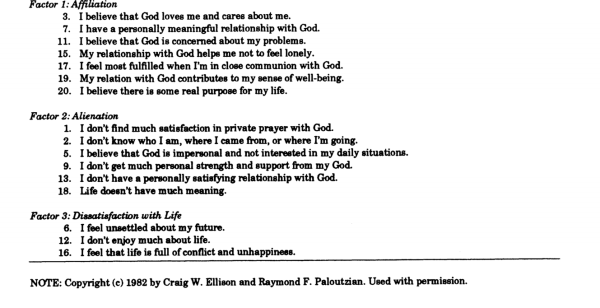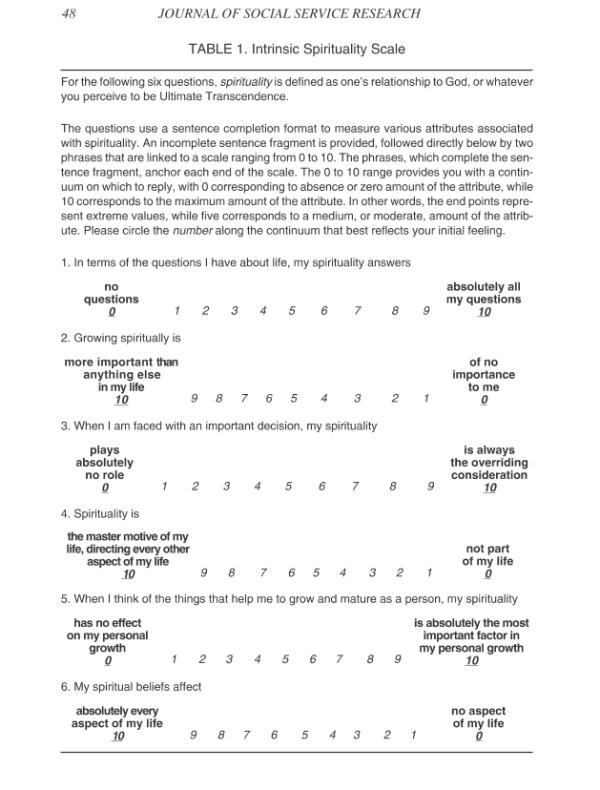Measurements
An Avatar.Global Resource
"Spielberger's State‐Trait Anxiety Inventory‐Global (STAI‐G) score" [1]
Measurements of Connection (mystical) Experience
Connection Experience > APZ (Abnormal Mental States) Questionnaire, Hood's Mysticism Scale, Mystical Experience Questionaire 30 Item, States of Consciousness Questonnaire
Measurements of Spiritual Well-being
Multidimensional Inventory of Religious/Spiritual Well-Being (MI-RSWB)
Notes
When validating surveys, "there should be at least 5 times as man participants as items or at least 200 respondents." Scales that are missing response items should not be included fr validation. [2]
Using scales allows "quantitative, credible method of spiritual inquiry with their patients, providing an avenue for integrating spiritual assessment with traditional medicine, much in the way that the mental status examination integrates mental assessment with traditional medicine.[22] Second, such a scale would facilitate the scientific study of the role of patient spirituality in medical care, since scientific inquiry is facilitated by an objective measurement method."[3]
Hill and Hood provide an overview of "measures of religiosity"[4]
Measurements of Religiosity
Religious Orientation Scale
Assesses only religious beliefs and behaviours. [5]
Index of Religiousness
Assesses only religious beliefs and behaviours.[7]
Measurements of Spirituality
Kwonmok et al. provide a list of instruments devoted to measuring Connection Outcomes.[8]
The Spirituality Scale (SS)
Twenty-three items
"The Spirituality Scale (SS) (Delaney, 2003) is a holistic assessment instrument that focuses on the beliefs, intuitions, lifestyle choices, practices, and rituals that represent the human spiritual dimension. The SS is designed to assess the essence of spirituality in a format that can be used to guide spiritual interventions." [9] Authors originally theorized four dimensions to spirituality, "spirituality and religion" (relationship with God or a higher power), "spirituality and meaning and purpose," "spirituality and relationships," and "spirituality and ecology." Subsequent validation reduced to three factors, religions and existential purpose, spirituality and relationships, and spirituality and ecology[10]

The Spiritual Well Being Scale (SWBS)
"The SWBS was developed in conjunction with the social indicators movement in the 1960's and 1970's (Bufford, Paloutzian, and Ellison 1991). As part of this movement the U.S. government tried to develop measures and indicators to assess whether or not the quality of life of U.S. citizens was improving. For example, data on suicide rates, crime, alcoholism, physical and mental health, and housing conditions from around the country were collected each year. The government hypothesized that these indicators would provide some insight into the quality of life in the United States. Paloutzian and Ellison (1979) believed that is was important to develop a measure that looked at subjective aspects of people's lives. Noting that there had been little attention to the spiritual and existential aspects of people's lives, they developed the Spiritual Well- Being Scale (Campise, Ellison, and Kinsman 1979). The Scale expanded on the work of Moberg (1978), and consists of two dimensions. The first is a vertical dimension, assessing one's relationship with God. The second dimension represents a more horizontal relation- ship with others and one's sense of personal satisfaction and meaning in life (Ellison 1983)."[11]
Note scale criticised for being biased in favour of "expression of faith consistent with evangelical Christian traditions."[12] Hatch et. al [13] point to several additional limitations
"The SWB is a 20-item, self-administered scale with two dimensions: religion and existential....the SWB Scale remains the most widely used instrument to assess spirituality as well as the one most frequently referred to and applied in studies examining spirituality," although there are methodological problems, like its Judeo-Christian bias. [14] For the scale.[15]
Focusses on a "search form meaning and purpose", with references to Frankl.

Spiritual Involvement and Beliefs (SIBS) Scale
26-item scale measures "spiritually salient activities and convictions."[16]
Focus on "religions and existential aspects," [17] like purpose, fulfillment, being thankful, forgiveness, belief in a higher power, and identity. Also asks some questions about the frequency of prayer and meditation, Items available. Original paper includes items, scoring, and four-factor analysis, (a) External/Ritual, (b) Internal/Fluid, (c) Existential/Meditative, and (d) Humility/Personal Application.
Dong et. al provide validation and alternative factor analysis.[18]
Underlying principles upon which it is based a theory-less hodgepodge of items.
Spiritual Assessment Scale
Assesses the "relational aspect of spirituality." "The Spiritual Assessment Scale (SAS) (Howden, 1992) is an instru- ment that represents the relational aspect of spirituality. The SAS is a 28-item instrument based on a conceptualization of spirituality as a phenomenon with four critical attributes: purpose and meaning in life, inner resources, unifying interconnectedness, and transcendence. "[19]
Index of Core Spiritual Experiences
The Intrinsic Spirituality Scale
The Intrinsic Spirituality Scale - six items that measure "intrinsic" spirituality, people who "live their religion" rather than "use religion," people with some "connectedness with Transcendence" and whose beliefs provide a "master motive" for life.[22] Builds on the intrinsic spirituality scale of Allport and Ross.[23]
Validates the scale by assessing correlation with attachment and alcohol use. Uses three items to assess alcohol use and three attachment items.
"level of intrinsic spirituality is indicated by taking the sum of their scores on the six items and dividing by six," with a theoretical range between 0 and 10 [24]
Note, although authors suggest this measures connection with the "Transcendent," does not contain any questions that might refer to that directly.

The Spiritual Perspective Scale (SPS)
Developed by Reed [25]
SPS [26]
"...an instrument that represents the existential aspect of spirituality. The SPS is a 10- item instrument with a 6-point Likert-type scale that can also be used as a semistructured interview."[27]
Developed and Revised by Reed (1986‚ 1987)
1. In talking with your family or friends‚ how often do you mention spiritual matters?
2. How often do you share with others the problems and joys of living according to your spiritual beliefs?
3. How often do you read spiritually-related material?
4. How often do you engage in private prayer or meditation?
5. Forgiveness is an important part of my spirituality.
6. I seek spiritual guidance in making decisions in my everyday life.
7. My spirituality is a significant part of my life.
8. I frequently feel very close to God or a “higher power” in prayer‚ during public worship or at important moments in my daily life.
9. My spiritual views have had an influence upon my life.
10. My spirituality is especially important to me because it answers many questions about the meaning of life.
If possible‚ please describe how you define spirituality on the back of this page‚ or provide any other comments you feel are important for the researcher to know about.
Items 1 to 4
1=Not at all‚ 2=Less than once a year‚ 3=About once a year‚ 4=About once a month‚ 5=About once a week‚ 6=About once a day
Items 5 to 10
1=Strongly Disagree‚ 2= Disagree‚ 3=Disagree more than agree‚ 4=Agree more than disagree‚ 5=Agree‚ 6=Strongly Agree
Citation and Legal
Treat the SpiritWiki as an open-access online monograph or structured textbook. You may freely use information in the SpiritWiki; however, attribution, citation, and/or direct linking are ethically required.
Footnotes
- ↑ “LSD Reduces Anxiety Symptoms in Phase 2 Trial.,” Brown University Psychopharmacology Update 34, no. 1 (January 2023): 2, https://doi.org/10.1002/pu.30965.
- ↑ Delaney, C. “The Spirituality Scale: Development and Psychometric Testing of a Holistic Instrument to Assess the Human Spiritual Dimension.” Journal of Holistic Nursing. United States: Sage Publications, January 1, 2005. British Library Document Supply Centre Inside Serials & Conference Proceedings. p. 154.
- ↑ Hatch, Robert L., Mary Ann Burg, Debra S. Naberhaus, and Linda K. Hellmich. “The Spiritual Involvement and Beliefs Scale.” Journal of Family Practice 46, no. 6 (1998): 476–86. p. ??
- ↑ Hill, P.C., and R.W. Hood. Measures of Religiosity. Birmingham, AL: Religious Education Press, 1999
- ↑ Hatch, Robert L., Mary Ann Burg, Debra S. Naberhaus, and Linda K. Hellmich. “The Spiritual Involvement and Beliefs Scale.” Journal of Family Practice 46, no. 6 (1998): 476–86.
- ↑ Hatch, Robert L., Mary Ann Burg, Debra S. Naberhaus, and Linda K. Hellmich. “The Spiritual Involvement and Beliefs Scale.” Journal of Family Practice 46, no. 6 (1998): 476–86.
- ↑ Hatch, Robert L., Mary Ann Burg, Debra S. Naberhaus, and Linda K. Hellmich. “The Spiritual Involvement and Beliefs Scale.” Journal of Family Practice 46, no. 6 (1998): 476–86.
- ↑ Kwonmok, Ko, Knight Gemma, James J Rucker, and Anthony J Cleare. “Psychedelics, Mystical Experience, and Therapeutic Efficacy: A Systematic Review.” Frontiers in Psychiatry 13 (July 1, 2022). https://doi.org/10.3389/fpsyt.2022.917199.
- ↑ Delaney, C. “The Spirituality Scale: Development and Psychometric Testing of a Holistic Instrument to Assess the Human Spiritual Dimension.” Journal of Holistic Nursing. United States: Sage Publications, January 1, 2005. British Library Document Supply Centre Inside Serials & Conference Proceedings
- ↑ Delaney, C. “The Spirituality Scale: Development and Psychometric Testing of a Holistic Instrument to Assess the Human Spiritual Dimension.” Journal of Holistic Nursing. United States: Sage Publications, January 1, 2005. British Library Document Supply Centre Inside Serials & Conference Proceedings.p. 149.
- ↑ Scott, Eric L., Albert A. Agresti, and George Fitchett. “Factor Analysis of the ‘Spiritual Well-Being Scale’ and Its Clinical Utility with Psychiatric Inpatients.” Journal for the Scientific Study of Religion 37, no. 2 (1998): 314–21. https://doi.org/10.2307/1387530. p. 314
- ↑ Scott, Eric L., Albert A. Agresti, and George Fitchett. “Factor Analysis of the ‘Spiritual Well-Being Scale’ and Its Clinical Utility with Psychiatric Inpatients.” Journal for the Scientific Study of Religion 37, no. 2 (1998): 314–21. https://doi.org/10.2307/1387530. p. 315.
- ↑ Hatch, Robert L., Mary Ann Burg, Debra S. Naberhaus, and Linda K. Hellmich. “The Spiritual Involvement and Beliefs Scale.” Journal of Family Practice 46, no. 6 (1998): 476–86.
- ↑ Delaney, C. “The Spirituality Scale: Development and Psychometric Testing of a Holistic Instrument to Assess the Human Spiritual Dimension.” Journal of Holistic Nursing. United States: SAGE PUBLICATIONS LTD, January 1, 2005. British Library Document Supply Centre Inside Serials & Conference Proceedings. p. 147-148.
- ↑ Paloutzian, R.F., and C.W. Ellison. “Loneliness, Spiritual Well-Being, and Quality of Life.” In Loneliness: A Sourcebook for Practice, edited by L.A. Peplau and D. Pearlman, 358–64. New York: Wiley, 1982.
- ↑ Dong, Shengli, Daniel Fioramonti, Amanda Campbell, and Deborah Ebener. “Validation of the Spiritual Involvement and Beliefs Scale in a College Student Sample.” Journal of Spirituality in Mental Health 20, no. 2 (April 2018): 167–84. https://doi.org/10.1080/19349637.2017.1360169. p. 173.
- ↑ Delaney, C. “The Spirituality Scale: Development and Psychometric Testing of a Holistic Instrument to Assess the Human Spiritual Dimension.” Journal of Holistic Nursing. United States: Sage Publications, January 1, 2005. British Library Document Supply Centre Inside Serials & Conference Proceedings.p. 149.
- ↑ Dong, Shengli, Daniel Fioramonti, Amanda Campbell, and Deborah Ebener. “Validation of the Spiritual Involvement and Beliefs Scale in a College Student Sample.” Journal of Spirituality in Mental Health 20, no. 2 (April 2018): 167–84. https://doi.org/10.1080/19349637.2017.1360169
- ↑ Delaney, C. “The Spirituality Scale: Development and Psychometric Testing of a Holistic Instrument to Assess the Human Spiritual Dimension.” Journal of Holistic Nursing. United States: Sage Publications, January 1, 2005. British Library Document Supply Centre Inside Serials & Conference Proceeding. p. 150.s
- ↑ O’Brien, M. “The Need for Spiritual Integrity.” In Human Needs and the Nursing Process, edited by H Yura and M Walsh, 23–27. Norwalk, CT: Appleton & Lange, 1982.
- ↑ Kass, Jared D., Richard Friedman, Jane Leserman, Patricia C. Zuttermeister, and Herbert Benson. “Health Outcomes and a New Index of Spiritual Experience.” Journal for the Scientific Study of Religion 30, no. 2 (June 1, 1991): 203–11. https://doi.org/10.2307/1387214.
- ↑ Hodge, David R. “The Intrinsic Spirituality Scale: A New Six-Item Instrument for Assessing the Salience of Spirituality as a Motivational Construct.” Journal of Social Service Research 30, no. 1 (January 1, 2003): 41–61.
- ↑ Allport, Gordon W., and J. Michael Ross. “Personal Religious Orientation and Prejudice.” Journal of Personality and Social Psychology 5, no. 4 (April 1967): 432–43. https://doi.org/10.1037/h0021212.
- ↑ Ibid. p. 55
- ↑ Reed, Pamela G. “Spirituality and Well-Being in Terminally Ill Hospitalized Adults.” Research in Nursing & Health 10, no. 5 (October 1, 1987): 335–44. https://doi.org/10.1002/nur.4770100507.
- ↑ Chen, Fengyi, Yi Zhang, Lingjun Zhou, and Jing Cui. “Psychometric Evaluation of the Spiritual Perspective Scale in Palliative Care Nurses in China.” Journal of Religion and Health 61, no. 4 (August 2022): 2804–18. https://doi.org/10.1007/s10943-022-01582-w.
- ↑ Delaney, C. “The Spirituality Scale: Development and Psychometric Testing of a Holistic Instrument to Assess the Human Spiritual Dimension.” Journal of Holistic Nursing. United States: Sage Publications, January 1, 2005. British Library Document Supply Centre Inside Serials & Conference Proceedings
